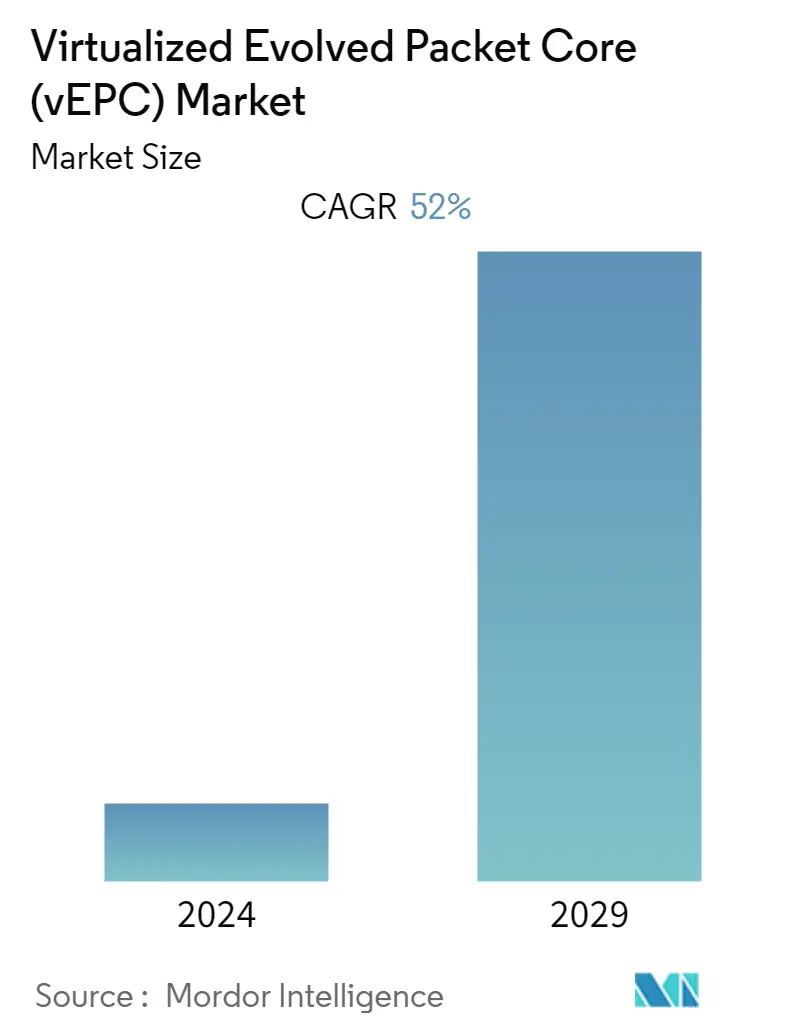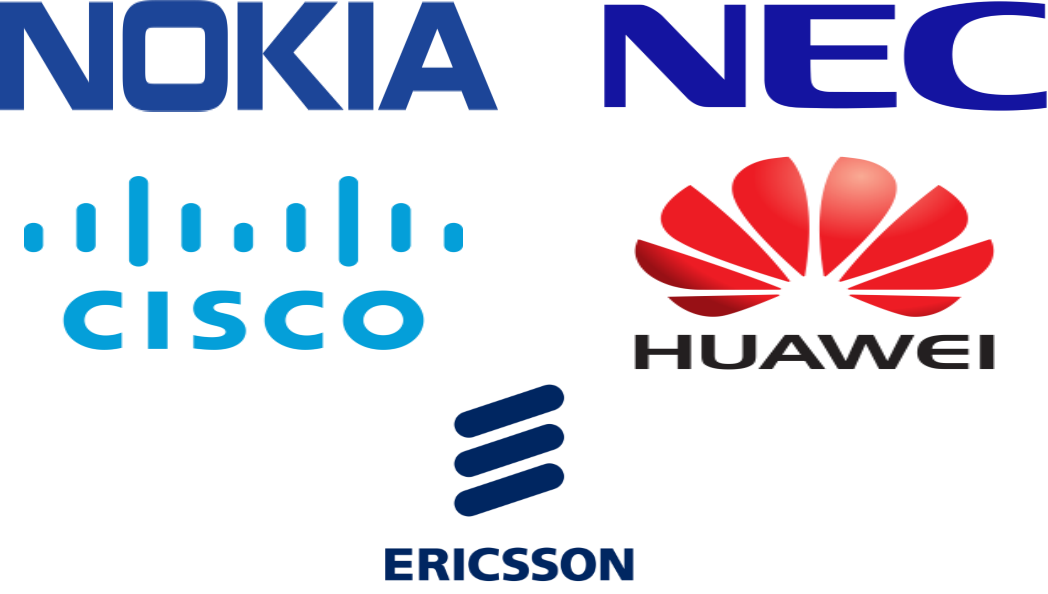
| Study Period | 2019 - 2029 |
| Base Year For Estimation | 2023 |
| Forecast Data Period | 2024 - 2029 |
| CAGR | 52.00 % |
| Fastest Growing Market | Asia Pacific |
| Largest Market | North America |
| Market Concentration | Low |
Major Players
*Disclaimer: Major Players sorted in no particular order |
Virtualized Evolved Packet Core Market Analysis
The virtualized evolved packet core market is expected to register a CAGR of 52% over the forecast period (2021-2026). A virtualized evolved packet core refers to a framework that helps the convergence of voice and data on 4G and 5G networks. Growth in the market is primarily attributable to the potential of vEPC and promotion of high-quality mobile services because of it.
- Due to the rapid increase in the number of mobile long-term evolution (LTE) subscribers across the globe, the vEPC market is growing at a fast pace. Enterprises are adopting vEPC, and it is expected to trigger the growth of the vPEC market in the upcoming years.
- Development of 5G infrastructure is driving the virtualized evolved packet core market. There have been many new advances in technology, such as 5G in the telecommunication industry. Due to increasing data traffic, the use of technologies such as IoT is encouraging MNOs to deploy 5G infrastructure. 5G will enable faster data transfer and provisioning of network services on demand. Thus, MNOs across the world are expected to implement vEPC to enhance their networks to utilise radio resources and increase their network capacity efficiently.
- The factor responsible for hindering the growth of the market is the reluctance in transiting from legacy infrastructure to virtualization.
- Companies are implementing vEPC for enterprise data centre networks. The rising deployment of vEPC by telecommunication operators is also encouraging enterprise cloud and ISPs for adopting vEPC. The implementation of vEPC is mostly taking place for improving the flexibility of cloud-based services while increasing the focus on network virtualization by enterprises.
Virtualized Evolved Packet Core Industry Segmentation
Virtualized evolved packet core is a framework used for virtualizing the functions required to converge voice and data on 4G Long-term evolution networks. It supports 2G, 3G, non-3GPP standards, wireless broadband, and the 5G core network. It is a mobile-core network system that accommodates LTE access systems and it is powered by a carrier-grade virtualization platform and software-defined networking (SDN) technology.
| Cloud-based |
| On-premise |
| IoT & M2M |
| MPN & MVNO |
| BWA |
| LTE, Volte & VoWiFi |
| North America |
| Europe |
| Asia-Pacific |
| Latin America |
| Middle East & Africa |
Virtualized Evolved Packet Core (vEPC) Market Size Summary
The virtualized evolved packet core (vEPC) market is experiencing rapid growth, driven by the increasing adoption of 4G and 5G networks. This growth is primarily fueled by the need for high-quality mobile services and the convergence of voice and data. The development of 5G infrastructure is a significant catalyst, as it enables faster data transfer and on-demand network service provisioning. Mobile network operators (MNOs) are implementing vEPC to enhance network capacity and efficiently utilize radio resources. However, the transition from legacy infrastructure to virtualization remains a challenge, potentially hindering market expansion. The market is also seeing increased deployment of vEPC in enterprise data center networks, with telecommunications operators encouraging cloud service providers and internet service providers to adopt these solutions for improved flexibility and network virtualization.
The IoT and M2M services segment is poised for substantial growth, presenting significant opportunities for vEPC solution providers. The deployment of vEPC in IoT core networks facilitates superior connectivity for M2M devices, enabling operators to explore new customer services. North America is expected to hold a significant market share due to the presence of major telecom companies and advanced network infrastructure. The region's growth is supported by government initiatives and the increasing demand for multimedia services and VoLTE. Companies like Mavenir Inc. are leading the charge in providing vEPC solutions, focusing on 5G-equipped, software-centered offerings. The market is moderately fragmented, with companies pursuing partnerships and acquisitions to expand their reach and enhance service offerings.
Virtualized Evolved Packet Core (vEPC) Market Size - Table of Contents
1. MARKET DYNAMICS
- 1.1 Market Overview
- 1.2 Introduction to Market Drivers and Restraints
-
1.3 Market Drivers
- 1.3.1 Increasing Number of Mobile LTE Subscribers
- 1.3.2 Development of 5G Infrastructure
-
1.4 Market Restraints
- 1.4.1 Reluctance in Transiting From Legacy Infrastructure to Virtualization
- 1.5 Industry Value Chain Analysis
-
1.6 Industry Attractiveness - Porter's Five Force Analysis
- 1.6.1 Threat of New Entrants
- 1.6.2 Bargaining Power of Buyers/Consumers
- 1.6.3 Bargaining Power of Suppliers
- 1.6.4 Threat of Substitute Products
- 1.6.5 Intensity of Competitive Rivalry
2. MARKET SEGMENTATION
-
2.1 By Deployment Mode
- 2.1.1 Cloud-based
- 2.1.2 On-premise
-
2.2 By Application
- 2.2.1 IoT & M2M
- 2.2.2 MPN & MVNO
- 2.2.3 BWA
- 2.2.4 LTE, Volte & VoWiFi
-
2.3 Geography
- 2.3.1 North America
- 2.3.2 Europe
- 2.3.3 Asia-Pacific
- 2.3.4 Latin America
- 2.3.5 Middle East & Africa
Virtualized Evolved Packet Core Market Research FAQs
What is the current Virtualized Evolved Packet Core (vEPC) Market size?
The Virtualized Evolved Packet Core (vEPC) Market is projected to register a CAGR of 52% during the forecast period (2025-2030)
Who are the key players in Virtualized Evolved Packet Core (vEPC) Market?
Ericsson India Pvt. Ltd., Huawei Technologies Co. Ltd., Cisco Systems Inc., NEC Corporation and Nokia Corporation are the major companies operating in the Virtualized Evolved Packet Core (vEPC) Market.


